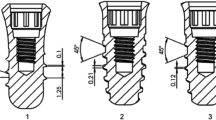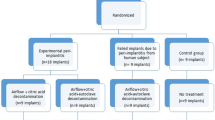Abstract
The current study aimed at examining surface and chemical composition changes of retrieved mini-implants after different periods of service as aids of anchorage for orthodontic patients. This study examined 72 retrieved orthodontic self-tapping and self-drilling mini-implants, 1.7 mm in diameter and 8 mm in length (OrthoEasy system, Forestadent, Pforzheim, Germany) from 36 adult orthodontic patients (18 men and 18 women, mean age = 23 years). The retrieved mini-implants were divided into 3 groups according to service period: 3–6 months (3M–6M) group, 6–12 months (6M–12M) group, and 12–24 months (12M–24M) group, with 24 mini-implants in each group. The control group (As Received) comprised of 24 unused mini-implants of the same type (AR group). All mini-implant heads and threaded bodies were examined for chemical characterization and topographical features by SEM–EDS. The average weight percentages for the following elements Ti, Al, and O2 were obtained and compared among the 4 groups. There was significant decrease in titanium content and deterioration for the surface properties for all parts of the mini-implants after being used inside patients’ oral cavities for more than 6 months p < 0.05. The period of mini-implant service inside patients’ oral cavities should not exceed 6 months.



Similar content being viewed by others
References
Vilani GN, Ruellas AC, Mattos CT, Fernandes DJ, Elias CN. Influence of cortical thickness on the stability of mini-implants with microthreads. Braz Oral Res. 2015;29:1–7.
Favero L, Brollo P, Bressan E. Orthodontic anchorage with specific fixtures: related study analysis. Am J Orthod Dentofac Orthop. 2002;122:84–94.
Huang LH, Shotwell JL, Wang HL. Dental implants for orthodontic anchorage. Am J Orthod Dentofac Orthop. 2005;127:713–22.
Kuroda S, Katayama A, Takano-Yamamoto T. Severe anterior open-bite case treated using titanium screw anchorage. Angle Orthod. 2004;74:558–67.
Miyawaki S, Koyama I, Inoue M, et al. Factors associated with the stability of titanium screws placed in the posterior region for orthodontic anchorage. Am J Orthod Dentofac Orthop. 2003;124:373–8.
Park YC, Lee SY, Kim DH, Jee SH. Intrusion of posterior teeth using mini-screw implants. Am J Orthod Dentofac Orthop. 2003;123:690–4.
Zawawi KH. Acceptance of orthodontic miniscrews as temporary anchorage devices. Patient Preference Adherence. 2014;8:933–7.
Justens E, De Bruyn H. Clinical outcome of mini-screws used as orthodontic anchorage. Clin Implant Dent Relat Res. 2008;10:174–80.
Ichinose S, Muneta T, Sekiya I, et al. The study of metal ion release and cytotoxicity in Co–Cr–Mo and Ti–Al–V alloy in total knee prosthesis—scanning electron microscopic observation. J Mater Sci Mater Med. 2003;14:79–86.
Schatzle M, Mannchen R, Zwahlen M, Lang NP. Survival and failure rates of orthodontic temporary anchorage devices: a systematic review. Clin Oral Implants Res. 2009;20:1351–9.
Buchter A, Wiechmann D, Koerdt S, et al. Load-related implant reaction of mini-implants used for orthodontic anchorage. Clin Oral Implants Res. 2005;16:473–9.
Abbassy MABA. The effect of fluoride on beta-titanium orthodontic wires surface texture and friction resistance. Int J Dent Oral Sci. 2015;2:47–52.
Yokoyama K, Kaneko K, Ogawa T, et al. Hydrogen embrittlement of work-hardened Ni–Ti alloy in fluoride solutions. Biomaterials. 2005;26:101–8.
Chassot E, Irigaray JL, Terver S, Vanneuville G. Contamination by metallic elements released from joint prostheses. Med Eng Phys. 2004;26:193–9.
Sedarat C, Harmand MF, Naji A, Nowzari H. In vitro kinetic evaluation of titanium alloy biodegradation. J Periodontal Res. 2001;36:269–74.
Meyer U, Buhner M, Buchter A, et al. Fast element mapping of titanium wear around implants of different surface structures. Clin Oral Implants Res. 2006;17:206–11.
Urban RM, Jacobs JJ, Tomlinson MJ, et al. Dissemination of wear particles to the liver, spleen, and abdominal lymph nodes of patients with hip or knee replacement. J Bone Joint Surg Am. 2000;82:457–76.
Licausi MP, Igual Munoz A, Amigo Borras V. Influence of the fabrication process and fluoride content on the tribocorrosion behaviour of Ti6Al4V biomedical alloy in artificial saliva. J Mech Behav Biomed Mater. 2013;20:137–48.
Patil P, Kharbanda OP, Duggal R, Das TK, Kalyanasundaram D. Surface deterioration and elemental composition of retrieved orthodontic miniscrews. Am J Orthod Dentofac Orthop. 2015;147:S88–100.
Eliades T, Zinelis S, Papadopoulos MA, Eliades G. Characterization of retrieved orthodontic miniscrew implants. Am J Orthod Dentofac Orthop. 2009;135:10e1–7 (discussion -1).
de Morais LS, Serra GG, Albuquerque Palermo EF, et al. Systemic levels of metallic ions released from orthodontic mini-implants. Am J Orthod Dentofac Orthop. 2009;135:522–9.
Nakagawa M, Matsuya S, Shiraishi T, Ohta M. Effect of fluoride concentration and pH on corrosion behavior of titanium for dental use. J Dent Res. 1999;78:1568–72.
Abbassy MA. Fluoride influences nickel-titanium orthodontic wires’ surface texture and friction resistance. J Orthod Sci. 2016;5:121–6.
Mabilleau G, Bourdon S, Joly-Guillou ML, et al. Influence of fluoride, hydrogen peroxide and lactic acid on the corrosion resistance of commercially pure titanium. Acta Biomater. 2006;2:121–9.
Mathew MT, Abbey S, Hallab NJ, et al. Influence of pH on the tribocorrosion behavior of CpTi in the oral environment: synergistic interactions of wear and corrosion. J Biomed Mater Res B Appl Biomater. 2012;100:1662–71.
Zhao B, Wang H, Qiao N, Wang C, Hu M. Corrosion resistance characteristics of a Ti–6Al–4V alloy scaffold that is fabricated by electron beam melting and selective laser melting for implantation in vivo. Mater Sci Eng C Mater Biol Appl. 2017;70:832–41.
Steinemann SG. Metal implants and surface reactions. Injury. 1996;27(Suppl 3):SC16–22.
Scales JT. Black staining around titanium alloy prostheses—an orthopaedic enigma. J Bone Joint Surg Br. 1991;73:534–6.
Cadosch D, Chan E, Gautschi OP, Filgueira L. Metal is not inert: role of metal ions released by biocorrosion in aseptic loosening—current concepts. J Biomed Mater Res A. 2009;91:1252–62.
Cadosch D, Schlett CL, Gautschi OP, Frei HC, Filgueira L. Metal ions: important co-players in aseptic loosening. Z Orthop Unfall. 2010;148:393–7.
Cadosch D, Chan E, Gautschi OP, et al. Titanium IV ions induced human osteoclast differentiation and enhanced bone resorption in vitro. J Biomed Mater Res A. 2009;91:29–36.
Woodman JL, Jacobs JJ, Galante JO, Urban RM. Metal ion release from titanium-based prosthetic segmental replacements of long bones in baboons: a long-term study. J Orthop Res. 1984;1:421–30.
Garcia-Alonso MC, Saldana L, Valles G, et al. In vitro corrosion behaviour and osteoblast response of thermally oxidised Ti6Al4V alloy. Biomaterials. 2003;24:19–26.
Saldana L, Barranco V, Garcia-Alonso MC, et al. Concentration-dependent effects of titanium and aluminium ions released from thermally oxidized Ti6Al4V alloy on human osteoblasts. J Biomed Mater Res A. 2006;77:220–9.
Wennerberg A, Ide-Ektessabi A, Hatkamata S, et al. Titanium release from implants prepared with different surface roughness. Clin Oral Implants Res. 2004;15:505–12.
Weingart D, Steinemann S, Schilli W, et al. Titanium deposition in regional lymph nodes after insertion of titanium screw implants in maxillofacial region. Int J Oral Maxillofac Surg. 1994;23:450–2.
Liu P, Yao YN, Wu SD, et al. The efficacy of deferiprone on tissues aluminum removal and copper, zinc, manganese level in rabbits. J Inorg Biochem. 2005;99:1733–7.
Rae T. The biological response to titanium and titanium–aluminium–vanadium alloy particles. I. Tissue culture studies. Biomaterials. 1986;7:30–6.
Ys T. Research progress on laser surface modification of titanium alloys. Appl Surf Sci. 2005;242:177–84.
Heinemann G, Fichtl B, Vogt W. Pharmacokinetics of vanadium in humans after intravenous administration of a vanadium containing albumin solution. Br J Clin Pharmacol. 2003;55:241–5.
Brune D. Metal release from dental biomaterials. Biomaterials. 1986;7:163–75.
Acknowledgements
This work was funded by the Deanship of Scientific Research (DSR), King Abdulaziz University, Jeddah, under grant number 339/165/1433. The authors therefore acknowledge with thanks (DSR) for technical and financial support.
Author information
Authors and Affiliations
Corresponding author
Ethics declarations
Conflict of interest
The authors declare that they have no conflict of interest.
Rights and permissions
About this article
Cite this article
Abbassy, M.A., Bakry, A.S., Zawawi, K.H. et al. Long-term durability of orthodontic mini-implants. Odontology 106, 208–214 (2018). https://doi.org/10.1007/s10266-017-0319-0
Received:
Accepted:
Published:
Issue Date:
DOI: https://doi.org/10.1007/s10266-017-0319-0




